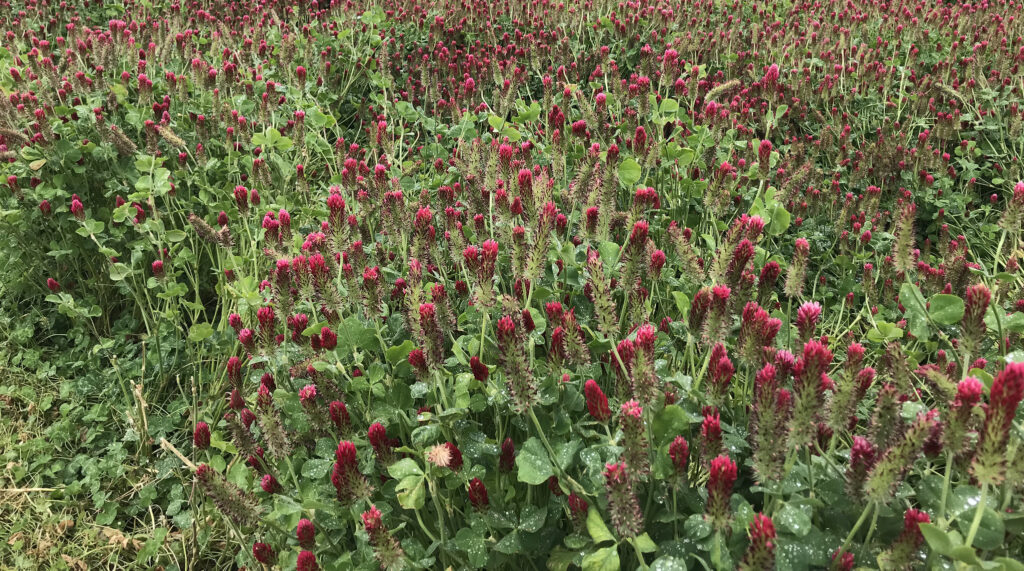No one wants to think of harvest’s end as the vegetable garden reaches peak, but now’s the time to plant over-winter cover crops to improve the soil for next season.
If you’re not acquainted with cover crops, here’s the rundown: These hardworking plants can add organic matter and aerate the soil, protect it from compaction caused by rain, suppress weeds and reduce erosion, according to Nick Andrews, organic vegetable specialist for Oregon State University Extension Service. As a bonus, if you let them flower, their blooms provide nectar and pollen for pollinators and other beneficial insects.

Not a bad deal for an almost no-maintenance plant. To get off to a good start, prepare your soil and broadcast plenty seed, lightly rake it in and water as needed until fall rains begin. Enjoy watching your cover crop grow during winter before you incorporate them in spring.
Cover crops include grains like winter oats, cereal rye and a wide range of broadleaf plants. Legumes, such as commonly used crimson clover, Austrian field pea and common vetch, are nitrogen “fixers.” Beneficial bacteria in legume root nodules take nitrogen from the air and supply it to the plant. When the cover crop decomposes in the spring, some of that nitrogen becomes available to fertilize next year’s vegetables. If cost is a concern, cover crop nitrogen from legumes is much cheaper than organic nitrogen fertilizer and competes with conventional fertilizer prices.
Timing is key for cover crops, Andrews said. Plant seeds of overwintering cover crops by September or early October before the weather turns too cold and wet for them to germinate and get established.
Make sure when you plant that the seed has good contact with the soil. Larger seeds like peas, vetch and cereals should be raked in lightly. Mix small seeds with sand to make them easier to broadcast and then use a sprinkler to water in. If the weather is still dry, keep the area irrigated. For vegetables you’re harvesting after early October, consider inter-seeding into your established crops during the summer before they cast too much shade for sun-loving vegetable plants.
Be prepared to manage your cover crop in the spring and kill it before it sets seed (unless you want some of the seed; fava beans, for example). In our climate, most gardeners incorporate cover crop residue to promote decomposition. Do this three to four weeks before planting vegetables so the crop decomposes well. Otherwise, it can promote some diseases and attract some insect pests.
If you don’t have three to four weeks for the cover crop to decompose, you can remove the stems and leaves and apply them somewhere else as a mulch or compost them, or double dig the cover crop deeper down into the soil. When to kill the crop depends on when you need to get your vegetables planted.
“Big is better when it comes to cover crops,” Anderson said. “If you can, let the crop grow until early flowering. Just be prepared to incorporate big crops if you grow them. You’ll see why organic farmers love cover crops.”
When it comes time to kill the cover crop, till shorter plants right into the soil. If the plant is too tall to turn under easily, mow first or use a weed trimmer. Tough-stemmed plants can be cut and left to decompose above ground. Or you can put the tops in the compost pile and dig in the roots. Some experienced gardeners who don’t want to till their soil are having good results with tarping, Andrews said. No matter the method, let the turned-under material sit until it’s time to plant.
For beginners, Andrews advises:
- Start with a cover crop that is easy to grow and manage. For example, crimson clover and phacelia are relatively easy to incorporate into the soil.
- Prepare your garden for cover crops and have sprinklers available if the weather is dry. It’s a good idea to water the soil a bit before preparing the seedbed if the soil is very dry.
- The first time you try cover crops, plant them in an area of your garden that you can leave for vegetables typically planted in May or June. This will buy you time to learn how to manage the cover crop residues in spring.
- After you have successfully used one cover crop, try another in a different area of your garden. Then when you gain experience, experiment with mixtures, interseeding, tarping and other innovative practices.
For more information, refer to Cover Crops for Home Gardeners East of the Cascades and West of the Cascades; and Methods for Successful Cover Crop Management for Gardeners, all publications by Washington State University that Andrews contributed to.
About OSU Extension: The Oregon State University Extension Service shares research-based knowledge with people and communities in Oregon’s 36 counties and the Confederated Tribes of Warm Springs. OSU Extension addresses issues that matter to urban and rural Oregonians. OSU Extension’s partnerships and programs contribute to a healthy, prosperous and sustainable future for Oregon.

